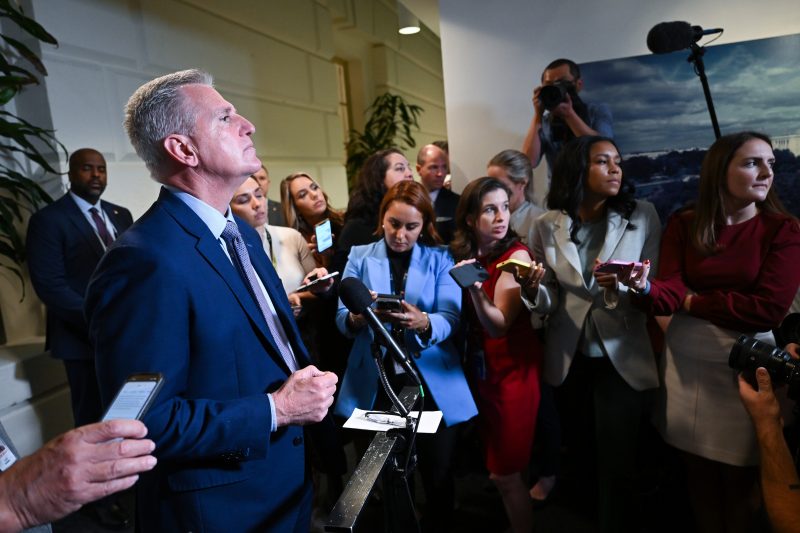Congress returns to Washington on Tuesday with fewer than five days to find an agreement that will avert a government shutdown.
That agreement so far does not exist.
House Speaker Kevin McCarthy (R-Calif.), faced with myriad demands from his hard-right flank, has been unable to unite his conference on a short-term path forward that would both appease the hard-liners and ensure he keeps his leadership position. Meanwhile, the Senate on Tuesday will begin moving ahead with its own short-term solution, known as a continuing resolution, or CR, by advancing a shell bill that can eventually house an expected bipartisan deal.
That bill, however, is probably dead on arrival in the House, unless Democrats and moderate Republicans tack it onto a vehicle that wouldn’t need leadership’s explicit approval for a floor vote. But even that course of action could cause McCarthy significant headaches, underscoring the complexity of the debate over policy and procedure that has upended the House Republican conference for several weeks.
By the end of the week, McCarthy could have to make a defining decision: Either put an expected bipartisan Senate stopgap bill on the House floor and risk his speakership, or withhold scheduling a vote on the Senate proposal and side with hard-right legislators in triggering a government shutdown, according to several lawmakers who spoke on the condition of anonymity to talk frankly about the inner workings of the conference.
McCarthy is unlikely to bring the eventual Senate proposal up for a vote because it would require Democratic support to pass, according to multiple Republican aides who spoke on the condition of anonymity to discuss internal party dynamics. Members on the hard right, including many within the staunchly conservative House Freedom Caucus, have said that relying on Democrats to move the bill would probably result in a Republican lawmaker filing a motion to remove McCarthy from his speakership.
“Anybody who switches teams might as well go and join the Democratic Party,” said Rep. Ralph Norman (R-S.C.), a member of the Freedom Caucus.
The looming government shutdown: What to know
End of carousel
A majority of House Republicans have backed previous plans, put forth by McCarthy and other rank-and-file members, that would fund the government for a short period and avert a shutdown. But those proposals have all failed to win the necessary support to be successful on the House floor, with a handful of holdouts publicly saying they will never support a stopgap measure. Republicans can lose only four votes to pass anything through their razor-thin majority, a situation made even more difficult as several lawmakers remain away from the House because of illness or newborn children.
Unable to move forward on a short-term plan, McCarthy and his allies have turned their focus to passing individual long-term appropriations bills — a key demand of a group of Republicans who are adamantly opposed to supporting any stopgap funding solutions. It’s a risky strategy given that House Republicans have failed twice to overcome a typically mundane procedural hurdle, known as a rule, on even the usually noncontroversial Department of Defense annual budget.
McCarthy and his allies appeared optimistic over the weekend that the House could advance four of the 11 remaining appropriations bills this week — measures that would fund defense, agriculture, the State Department and homeland security for a full fiscal year — in a strategy that the speaker hopes will buy enough goodwill among his conference to pass a stopgap funding measure by the end of the week.
“I don’t think we can get all 12 of them done, but I think we can get those four, and those are the bulk of the spending for the overall budget,” Rep. Jim Jordan (R-Ohio), a founder of the House Freedom Caucus, told Fox News on Sunday. “But we do need — as we’ve talked about now — we do need to get that stopgap measure, that CR, sent to the Senate.”
But simply passing four appropriations bills would do nothing to prevent a government shutdown starting Oct. 1. Complicating matters further is that those bills remain nonstarters in the Senate, which has marked up its 12 appropriations proposals to levels agreed to by McCarthy and the White House earlier this year in exchange for raising the debt ceiling.
More pragmatic House Republicans have lamented that their hard-liner colleagues are spending precious time fighting over whether their full-year bills are conservative enough without recognizing that failing to pass a stopgap measure would prevent them from achieving their goal of passing all 12 appropriations bills and addressing border security. Some have been equally as blunt that their current proposals could not pass the Senate and be signed by President Biden — basic principles of government that a handful of lawmakers do not to recognize.
“I think that every day we get closer to the end of the fiscal year, the opportunities or the leverage to force this White House, to force President Biden, to cave on those issues is waning,” said Rep. Garret Graves (R-La.), an ally of McCarthy. “And I think it’s a huge mistake.”
Aware that their party would probably be faulted for sparking a shutdown, some McCarthy allies have begun singling out the handful of hard-liners who refused to move the defense appropriations bill last week.
In a Sunday interview with ABC News, Rep. Michael R. Turner (R-Ohio) accused the holdouts of working with Democrats “to try to cause the shutdown.”
“These individuals, these Republican holdouts, are voting with Nancy Pelosi against Republican bills that have been brought to the floor, that will — could trigger a shutdown,” he said. “Kevin [McCarthy] is going to continue to negotiate until the end. But, you know, the Republicans need to vote for Republican bills, and we can avert the shutdown.”
But Rep. Matt Gaetz (R-Fla.), one of the main obstructionists, who has vowed to file a motion to remove McCarthy from the speakership if he does not cede to hard-liners’ demands, dismissed the accusations, saying he has no personal “vendetta” against McCarthy but rather the system under which Congress passes appropriations bills.
“My vendetta is against a Washington system that allows corruption to put the interests of lobbyists and PACs above the interests of the American people,” he told Fox News. “Kevin McCarthy facilitates that system, and I do deeply resent that. But I’m not working with Chuck Schumer or any other Democrat.”
After a Saturday call previewing the rules package that will allow Republicans to advance the four appropriations bills, Rules Committee member Rep. Erin Houchin (R-Ind.) dismissed allegations by hard-liners that House GOP leadership was rushing through votes on spending bills, noting that the conference has been working on these measures for months.
“We’ve been trying to get these bills to the floor, [but] a handful of people have sort of been standing in the way,” she said.
Some moderate Republicans, in an effort to shorten a potential shutdown, have begun contemplating partnering with Democrats to sign on to a discharge petition — a potential escape hatch of sorts that would allow a bipartisan majority to bypass McCarthy and force a vote on legislation on the House floor. Moderates are considering using it to bring a stopgap bill up for a vote if McCarthy won’t.
However, bringing a discharge petition is a complicated, lengthy procedure that would not prevent a shutdown before Oct. 1. Discharge petitions require the collection of 218 signatures and a waiting period of seven legislative days before they can be moved forward.
Fortunately for lawmakers discussing the strategy, there’s already one discharge petition available — the one Democrats moved earlier this year as a safety valve should Republicans fail to lift the debt limit. That petition already has all Democrats signed on to it, meaning lawmakers need only five Republicans to sign on to force it to the floor if no Democrats remove their names.
Neither McCarthy nor House Minority Leader Hakeem Jeffries (D-N.Y.) has explicitly talked about bringing up a discharge petition. And while such a move would allow a majority of members to circumvent traditional procedure and largely avoid McCarthy, the speaker could attempt to slow or derail it through a couple of procedural tactics. It also could be a backdoor way for McCarthy to move a CR without having direct involvement.
While a variety of plans are being discussed outside of the leadership ranks, McCarthy’s allies stressed that moving forward with conservative bills remains the priority before turning to Democrats.
“The natural state of the House, just like in the Senate, just like every legislature body in America, is you start to build out your own votes within your party, if you can,” said Rep. Patrick T. McHenry (R-N.C.), another McCarthy ally. “And not until you exhaust that do you look at any other alternatives. That is just the way it is.”
Paul Kane contributed to this report.





























